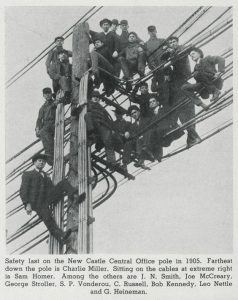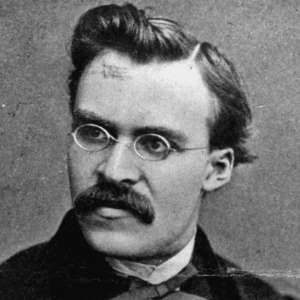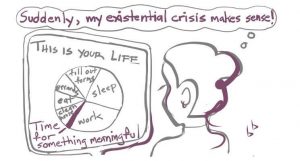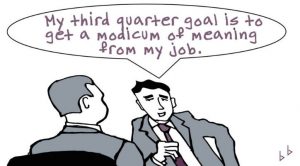
Those words might have worked as a rallying cry 75 or 100 years ago, when the U.S. was electrifying (right). Back then, working in the electricity business was a leading-edge, change-the-world endeavor, like working in the space program was in the 1960s or the perennial search for a cure for cancer.
But today, many utility employees need a more current, vibrant and relevant sense of purpose. “Reliable, Affordable and Safe” doesn’t stir anyone’s heartstrings. That’s not to say utilities should abandon those attributes and become, instead, unreliable, expensive and unsafe. But touting reliability, affordability and safety is akin to Southwest Airlines having a motto of, “Not crashing planes since 1967.”
Meaning at the Heart of Employee Engagement
Simon Sinek has been adroitly beating the drum for jobs with more meaning, inspiration and purpose for more than a decade. His book, Start with Why, and his TED Talk, which has been viewed over 36 million times, are powerful statements about people’s search for purpose and fulfillment.
The graphic below shows Sinek’s assertion, that a person’s or organization’s “Why” gives it emotional meaning and shapes critical “How” and “What” choices it must make.

Since we spend at least a quarter of our lives at our jobs, doesn’t it make sense that employees would start by looking for greater meaning and fulfillment there?
Employee Engagement: Thoughts from Nietzsche and Frankl

Sinek is by no means the first thinker to tackle this issue. Over a century ago, German philosopher Friedrich Nietzsche (right) said, “He who has a why to live can bear almost any how.” In his 1946 book, Man’s Search for Meaning, Viktor Frankl, a psychiatrist and survivor of the Nazi concentration camps, put it more directly: “If I know the why, I can do the what.”
I’m not comparing a corporate reorganization or a downsizing to Nazi concentration camps. That people seek meaning and fulfillment should be obvious.
Employee Engagement: A Problem for Utilities (and other Businesses!)
Anecdotal evidence suggests that utility employees have a flagging sense of engagement and commitment. EEC’s two surveys of utility communicators and marketers, Budgets, Gadgets and Price Increases and Juggling Chainsaws, showed employee engagement was the most or second-most important communications challenge for about 15% of those surveyed.
The problem is widespread: A 2013 Gallup survey of employees across industries and from around the world found 87% of workers felt disengaged, unmotivated or generally unhappy. Next time you’re in a meeting, consider that nearly 9 in 10 attendees are looking for more meaning or an exit ramp.

Bea Boccalandro (left) can help. The founder and president of VeraWorks, Bea has been working on what she calls “job purposing” for nearly a decade as an academic, advisor, consultant and speaker. Along the way, she had helped companies like Aetna, Allstate, Bank of America, Caesars Entertainment, Disney, FedEx, HP, IBM, Levi’s, PwC (PricewaterhouseCoopers) and Toyota, among others, incorporate societal good into their day-to-day business and measure its societal and business impact.
Employee Engagement Only One of the Benefits of Job Purposing
“Properly motivated, employees will work longer, harder and smarter,” she told me in a recent interview. “Dozens of studies show that the most effective and enduring motivator is meaning, not money.”
In addition to being a thought leader, Bea also is a talented artist. She describes herself as a “primitive artist, metrics-obsessed strategist and whimsical idealist.” She graciously allowed me to use several of her drawings in this post.
Communications Tip of the Month: Employee communications is critical for utilities trying to add purpose to the workplace. Job purposing guru Bea Boccalandro has found that, “Properly motivated, employees will work longer, harder and smarter. Dozens of studies show that the most effective and enduring motivator is meaning, not money.”
Bea’s stance regarding workplace purpose is not, however, mere whimsy. The academic literature is filled with case studies and analyses that underscore the importance of meaning in work. One of the earliest such pieces is Frederick Hertzberg’s classic article in Harvard Business Review, One More Time: How Do You Motivate Employees? Bea has a raft of academic and practitioner analyses that show a positive correlation between engaged employees, satisfied customers and higher stock prices. Doing good, it seems, really is the best way to do well.
About once a year, I blog on utility employee engagement. My earlier pieces include How’s That Employee Engagement Project Working?, Is Your Utility Headed for Trouble? and Boosting Your Utility’s Employee Engagement, CSAT and Profitability. I also wrote an article for Public Utilities Fortnightly on utility employee engagement, which is available for free to anyone who is interested.

Adding Purpose to Three Utility Jobs
Back to Bea: Job purposing, she said, “involves adjusting jobs, usually just slightly, so that they have an augmented social impact by helping either colleagues, customers, members of the public or a cause.” She provided three specific ideas for utilities:
- Utility meter readers might carry and donate books to children in low-income neighborhoods. FedEx drivers do acts of social good similar to this.
- When call volume is low, call center employees might be offered the opportunity to call donors of local nonprofits and thank them for their charitable donation to the utility’s nonprofit partner. LinkedIn applies a practice similar to this.
- An administrative assistant might be given the latitude of scheduling lunches at local restaurants that support sustainable local agriculture. Toyota practices something similar to this policy.
None of these are earth-shaking changes, though some performance metrics for some jobs might have to be adjusted. Longstanding metrics that focus solely on how rapidly an employee performs a task, such as reading a meter or answering customer calls, might have to be adjusted to allow employees to add purpose to their work, such as alleviating hunger and poverty, preventing environmental degradation or boosting literacy.
Want to Boost Safety? Improve Operational Performance? Add Purpose!
Even if, on paper, purposed jobs take a bit longer to be completed, the effect on over-arching operations might be positive. Studies find that we perform fewer errors, work longer and are less likely to leave a purposed job compared to a conventional job. For utilities worried about the impending “brain drain,” job purposing might be a way to ease the impact of an expected surge of retirements, particularly among hard-to-fill positions like lineman.

Utilities and electric cooperatives often say they exist to improve their local communities. For 100 years, that meant providing electricity or natural gas to those communities. But now that those communities are fully electrified and gasified, maybe the next mission is closer to home — improving the community in smaller, more personalized ways.
“Even a fairly rigid job can be stretched, at least a little, in the direction of doing good,” Bea said. She has a book on job purposing coming out later this year titled Do Good at Work. Interested readers can savor a taste by checking out her blog or a free download of her Job Purposing Essentials.
From measuring the impact of her work with clients, and backed by a growing body of academic and practitioner literature, Bea is confident that “Job purposing increases employee engagement, productivity and retention, and thus supports corporate financial performance. Making the world a slightly better place is more than worth the effort.”

Imagine a workplace where people bring their hearts and brains to work, where clock-watching becomes the exception not the rule, where sincere enthusiasm replaces meek compliance and where “Thank God it’s Monday” replaces “Thank God it’s Friday” as the informal slogan of employees. You can make it happen. Contact Bea now or click here to learn more about her work!
 Utility Employee Engagement
Utility Employee Engagement
The strategy team is pumped: “This initiative will rock the market,” they say. With no shortage of excitement, and just a touch of hyperbole, they proclaim a new and brighter future is at hand.
Are they talking about your impending merger? The rollout of advanced digital meters? The long-sought-after upgrade of the customer information system?
It doesn’t matter. Whatever strategic initiative is underway at your utility, you will need engaged employees to implement it. And engaged employees in a utility are pretty rare today.
7 in 10 strategic initiatives fail. To increase the probability that yours will succeed, check out this article I wrote for Public Utilities Fortnightly.
Read the article here.

